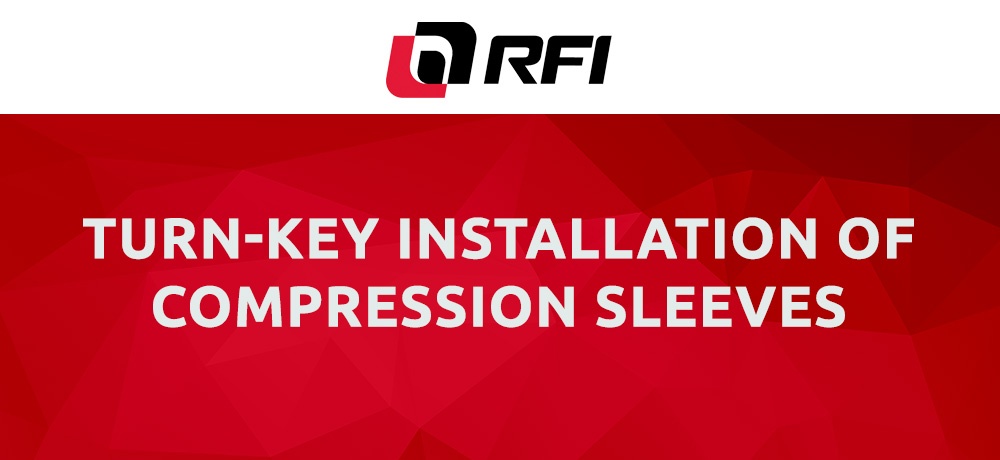Turn-Key Installation Of Compression Sleeves

Compression-type steel repair sleeves have a significant history of use for the repair of several types of piping anomalies. When properly installed, they have proven useful for the reduction of anomaly propagation and failure by imposing a compressive hoop stress in the pipe wall, including the anomaly. CSA Z662-2019 permits the use of compression-type repair sleeves for a range of anomalies including corrosion, mechanical damage, axial cracks, and some weld anomalies.
However, as with all material infrastructure, piping systems do need constant maintenance and special care to find and repair. One of the easiest ways to support ageing piping systems is by using compression sleeves to curb propagation on identified anomalies. To help you prepare and make the most out of this new installation procedure, Red Flame Industries Inc. has explained the advantages of our compression sleeve installation method.
Our New Compression Sleeve Install Method
Why mechanical compression as opposed to thermal compression? Through Red Flame research and development, it has shown that, without significant cooling on the inside of the piping system, the rate of heat transfer from the sleeve to the piping system exceeds a level that would reliably produce the desired compression. Simply put, the temperature difference between the piping system and the sleeve during welding can affect the level of compression achieved. Additionally, verifying by measurement does not confirm contraction of the sleeve but may give a false sense of compression given the variables such as heating, expansion, and contraction of the piping system itself.
Red Flame chose to pursue a more reliable and repeatable compression sleeve installation process that controlled as many variables as possible. Mechanical compression provides precise and repeatable compression given the input of numerous differing variables such as ambient temperature, flow of the piping system, temperature of the piping system, diameters, wall thickness, material type, etc. Utilizing torque values Red Flame can compute compressive forces imposed on the piping system (clamping bands), and from utilizing strain gauge analysis, prove even compression of the sleeve.
Pre-Work Assessment before Installation
Each installation of a Red Flame compression repair sleeve begins with an assessment of the anomaly type, severity, design parameters, and operating conditions. The sleeve thickness, material, and length are chosen by Red Flame Engineering to provide adequate reinforcement of the anomaly, and to minimize the tensile stress in the area of the anomaly at pressures up to and including the maximum allowable working pressure (MOP – Canada, MAWP – USA) of the piping system. A typical assessment will include an evaluation by FEA to ensure that the sleeve design, and the specified bolt loads produce suitable compressive stresses for the given application, the intent is to provide sufficient compressive loads from the repair sleeve to put the area containing the anomaly into compression at all potential operating pressures. Since the repair sleeve does not need to be heated, an assessment of the service fluid, flow rates, temperatures, and other variables related to heat transfer is not necessary.
How it Works
Red Flame compression repair sleeves are installed using high-strength bolted compression bands; the bands are designed to simultaneously compress the sleeve and piping system by tightening the assembly studs to a pre-determined torque using calibrated equipment. The tightened studs produce a predictable force which correlates to a compressive stress in the piping system and sleeve. Each bolted compression band is installed together and then removed one at a time, thereby exposing a section of the sleeve to be welded while the sleeve remains in compression.
Additional Information
While compression sleeves are highly effective and significantly increase your piping system’s life, it is necessary to laser scan to confirm the roundness of the pipe and the depth or density of any other anomalies that may affect the sleeves’ fit. Proper care must be taken to identify defects using non-destructive testing methods to ensure no surprises upon installation.
What makes our compression sleeve technology product stand out?
Coordinating numerous vendors for the supply, installation, and NDT (non-destructive testing) of the compression sleeve and piping solutions is an issue we have seen on multiple occasions. At Red Flame Industries Inc., our turn-key operation includes the supply of compression sleeves, welding, non-destructive testing, and installation of the compression sleeve, all of which is performed in-house. Our unique and verifiable mechanical installation method can determine precise compression in variable conditions without using open-flame or heating methods, making it a safer and more reliable process.
The equipment and methods developed by Red Flame Industries offer a simplified approach to compression-type repair sleeve installations that yields predictable and reliable results. By minimizing the effect of several external variables, the owner of a piping system can have confidence that the intended load reduction at the site of an anomaly is being achieved and that the long-term integrity of their piping system will be preserved.
For more information on compression sleeve systems, reach out to us by giving us a call at 1 (888) 846-8827 or visit our website at www.redflameindustries.com. We are a privately held company headquartered in Red Deer, Alberta, serving the oil, gas, petrochemical, and renewable resource industries. We expect to accelerate new and creative solutions that move our industry forward. For this, we offer hot taps, line stops, repair sleeves, well abandonment and re-entry, non-destructive testing, on-line pipe repair services, technical bolting and calibration, heat treatment, and field machining Iso-hydro testing, custom manufacturing, and supply, as well as technical tool sales and rentals.
To learn more about our services, please click here. If you have questions about the energy industry, contact us here.